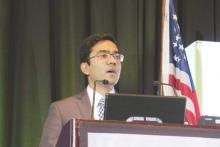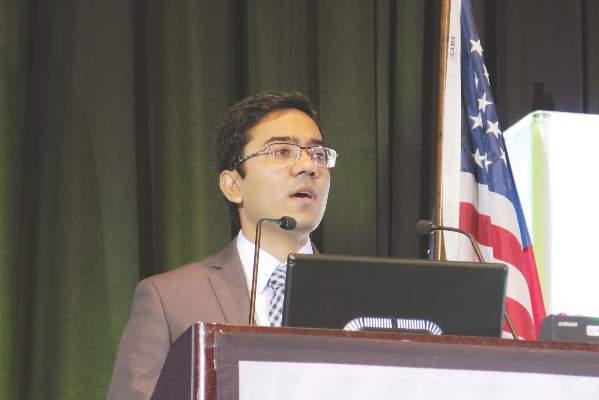User login
LAKE BUENA VISTA, FLA. – Patients undergoing emergency general surgery appear to fare better if managed at a certified acute care surgery trauma center, a nationwide analysis suggests.
“Patients managed at acute care surgery trauma centers had lower complication rates, shorter hospital length of stay, and lower hospital costs,” lead study author Dr. Mazhar Khalil said at the annual scientific assembly of the Eastern Association for the Surgery of Trauma.
Several single-institution studies have reported improved patient outcomes and system efficiencies following the 2008 creation of the American Association for the Surgery of Trauma (AAST) Acute Care Surgery fellowship. The ACS model has been endorsed by several professional organizations including EAST and the American College of Surgeons, but national outcomes have never been studied.
Dr. Khalil and his colleagues conducted a 1-year retrospective analysis of 131,410 patients who underwent emergency general surgery in 2011 in the National Inpatient Sample (NIS) database. The NIS is the largest all-payer, in-patient database in the United States and represents a stratified sample of 20% of all hospital discharges including 4,121 hospitals across 44 states.
ICD-9 codes were used to identify emergency general surgery procedures, defined as appendectomy, cholecystectomy, hernia repair, and small and large bowel resections. A total of 75,930 patients (58%) were managed at non–trauma centers (NTC), 47,753 (36%) at trauma centers (TC), and 7,727 (6%) at acute care surgery trauma centers (ACS-TC). Weekend admission rates were constant across all three groups at about 24%, as were the types of procedures performed.
In-hospital complications occurred in 18.1% of patients managed at AAST-certified acute care surgery trauma centers versus 18.7% among those at non–trauma centers and 19.4% at trauma centers (P = .04), Dr. Khalil, an international trauma fellow at the University of Arizona in Tucson, reported.
Between-group differences reached statistical significance for urinary tract infections (6.5% vs. 6.8% vs. 7.2%; P = .02), but not for the other complications of pneumonia, surgical site infection, sepsis, or reoperation.
AAST-certified ACS-TC patients had significantly shorter hospital stays than NTC or TC patients (7.2 days vs. 7.9 days vs. 8.5 days; P = .04) and lower average hospital costs ($60,000 vs. $70,000 vs. $67,000; P = .03), he said.
There was no difference in mortality across the three groups (2.1% vs. 2.4% vs. 2.2%; P = .12).
In multivariable analysis adjusted for age, gender, race, Charlson comorbidity index, type of procedure, complications, and weekend admission, patients at AAST-certified ACS-TC centers had lower odds than those at trauma centers for in-hospital complications (Odds ratio, 0.95 vs. 1.1) and hospital length of stay (OR, 0.91 vs. 1.2). Again, mortality was similar (OR, 0.98 vs. 1.07), Dr. Khalil said.
“The AAST-verified acute care surgery model should be a potential component of trauma programs practicing emergency general surgery,” he concluded.
During a discussion of the paper, concerns were raised that the results would be viewed as an overarching judgment of acute care surgery and whether the investigators could be certain the trauma centers were appropriately classified and the surgeries performed by an ACS fellow. Without correct classification, the entire premise of the paper could be undermined, it was argued.
Trauma center status was determined using the location of the center as provided in the NIS and cross-referenced with the American College of Surgeons Trauma registry, Dr. Khalil said. It was not possible to identify the centers that practice the ACS model, but are not certified by AAST.
He went on to say, “All these studies do is set up a foundation for future prospective studies. They are not definitive, authoritative answers to say that this is better than that.”
Dr. Khalil and his coauthors reported having no financial disclosures.
LAKE BUENA VISTA, FLA. – Patients undergoing emergency general surgery appear to fare better if managed at a certified acute care surgery trauma center, a nationwide analysis suggests.
“Patients managed at acute care surgery trauma centers had lower complication rates, shorter hospital length of stay, and lower hospital costs,” lead study author Dr. Mazhar Khalil said at the annual scientific assembly of the Eastern Association for the Surgery of Trauma.
Several single-institution studies have reported improved patient outcomes and system efficiencies following the 2008 creation of the American Association for the Surgery of Trauma (AAST) Acute Care Surgery fellowship. The ACS model has been endorsed by several professional organizations including EAST and the American College of Surgeons, but national outcomes have never been studied.
Dr. Khalil and his colleagues conducted a 1-year retrospective analysis of 131,410 patients who underwent emergency general surgery in 2011 in the National Inpatient Sample (NIS) database. The NIS is the largest all-payer, in-patient database in the United States and represents a stratified sample of 20% of all hospital discharges including 4,121 hospitals across 44 states.
ICD-9 codes were used to identify emergency general surgery procedures, defined as appendectomy, cholecystectomy, hernia repair, and small and large bowel resections. A total of 75,930 patients (58%) were managed at non–trauma centers (NTC), 47,753 (36%) at trauma centers (TC), and 7,727 (6%) at acute care surgery trauma centers (ACS-TC). Weekend admission rates were constant across all three groups at about 24%, as were the types of procedures performed.
In-hospital complications occurred in 18.1% of patients managed at AAST-certified acute care surgery trauma centers versus 18.7% among those at non–trauma centers and 19.4% at trauma centers (P = .04), Dr. Khalil, an international trauma fellow at the University of Arizona in Tucson, reported.
Between-group differences reached statistical significance for urinary tract infections (6.5% vs. 6.8% vs. 7.2%; P = .02), but not for the other complications of pneumonia, surgical site infection, sepsis, or reoperation.
AAST-certified ACS-TC patients had significantly shorter hospital stays than NTC or TC patients (7.2 days vs. 7.9 days vs. 8.5 days; P = .04) and lower average hospital costs ($60,000 vs. $70,000 vs. $67,000; P = .03), he said.
There was no difference in mortality across the three groups (2.1% vs. 2.4% vs. 2.2%; P = .12).
In multivariable analysis adjusted for age, gender, race, Charlson comorbidity index, type of procedure, complications, and weekend admission, patients at AAST-certified ACS-TC centers had lower odds than those at trauma centers for in-hospital complications (Odds ratio, 0.95 vs. 1.1) and hospital length of stay (OR, 0.91 vs. 1.2). Again, mortality was similar (OR, 0.98 vs. 1.07), Dr. Khalil said.
“The AAST-verified acute care surgery model should be a potential component of trauma programs practicing emergency general surgery,” he concluded.
During a discussion of the paper, concerns were raised that the results would be viewed as an overarching judgment of acute care surgery and whether the investigators could be certain the trauma centers were appropriately classified and the surgeries performed by an ACS fellow. Without correct classification, the entire premise of the paper could be undermined, it was argued.
Trauma center status was determined using the location of the center as provided in the NIS and cross-referenced with the American College of Surgeons Trauma registry, Dr. Khalil said. It was not possible to identify the centers that practice the ACS model, but are not certified by AAST.
He went on to say, “All these studies do is set up a foundation for future prospective studies. They are not definitive, authoritative answers to say that this is better than that.”
Dr. Khalil and his coauthors reported having no financial disclosures.
LAKE BUENA VISTA, FLA. – Patients undergoing emergency general surgery appear to fare better if managed at a certified acute care surgery trauma center, a nationwide analysis suggests.
“Patients managed at acute care surgery trauma centers had lower complication rates, shorter hospital length of stay, and lower hospital costs,” lead study author Dr. Mazhar Khalil said at the annual scientific assembly of the Eastern Association for the Surgery of Trauma.
Several single-institution studies have reported improved patient outcomes and system efficiencies following the 2008 creation of the American Association for the Surgery of Trauma (AAST) Acute Care Surgery fellowship. The ACS model has been endorsed by several professional organizations including EAST and the American College of Surgeons, but national outcomes have never been studied.
Dr. Khalil and his colleagues conducted a 1-year retrospective analysis of 131,410 patients who underwent emergency general surgery in 2011 in the National Inpatient Sample (NIS) database. The NIS is the largest all-payer, in-patient database in the United States and represents a stratified sample of 20% of all hospital discharges including 4,121 hospitals across 44 states.
ICD-9 codes were used to identify emergency general surgery procedures, defined as appendectomy, cholecystectomy, hernia repair, and small and large bowel resections. A total of 75,930 patients (58%) were managed at non–trauma centers (NTC), 47,753 (36%) at trauma centers (TC), and 7,727 (6%) at acute care surgery trauma centers (ACS-TC). Weekend admission rates were constant across all three groups at about 24%, as were the types of procedures performed.
In-hospital complications occurred in 18.1% of patients managed at AAST-certified acute care surgery trauma centers versus 18.7% among those at non–trauma centers and 19.4% at trauma centers (P = .04), Dr. Khalil, an international trauma fellow at the University of Arizona in Tucson, reported.
Between-group differences reached statistical significance for urinary tract infections (6.5% vs. 6.8% vs. 7.2%; P = .02), but not for the other complications of pneumonia, surgical site infection, sepsis, or reoperation.
AAST-certified ACS-TC patients had significantly shorter hospital stays than NTC or TC patients (7.2 days vs. 7.9 days vs. 8.5 days; P = .04) and lower average hospital costs ($60,000 vs. $70,000 vs. $67,000; P = .03), he said.
There was no difference in mortality across the three groups (2.1% vs. 2.4% vs. 2.2%; P = .12).
In multivariable analysis adjusted for age, gender, race, Charlson comorbidity index, type of procedure, complications, and weekend admission, patients at AAST-certified ACS-TC centers had lower odds than those at trauma centers for in-hospital complications (Odds ratio, 0.95 vs. 1.1) and hospital length of stay (OR, 0.91 vs. 1.2). Again, mortality was similar (OR, 0.98 vs. 1.07), Dr. Khalil said.
“The AAST-verified acute care surgery model should be a potential component of trauma programs practicing emergency general surgery,” he concluded.
During a discussion of the paper, concerns were raised that the results would be viewed as an overarching judgment of acute care surgery and whether the investigators could be certain the trauma centers were appropriately classified and the surgeries performed by an ACS fellow. Without correct classification, the entire premise of the paper could be undermined, it was argued.
Trauma center status was determined using the location of the center as provided in the NIS and cross-referenced with the American College of Surgeons Trauma registry, Dr. Khalil said. It was not possible to identify the centers that practice the ACS model, but are not certified by AAST.
He went on to say, “All these studies do is set up a foundation for future prospective studies. They are not definitive, authoritative answers to say that this is better than that.”
Dr. Khalil and his coauthors reported having no financial disclosures.
AT THE EAST SCIENTIFIC ASSEMBLY
Key clinical point: Patients managed at certified acute care surgery trauma centers had fewer complications, shorter hospital stays, and lower hospital costs.
Major finding: In-hospital complications rates were lower in patients at ACS trauma centers than at non–trauma centers and trauma centers (18.1% vs. 18.7% vs. 19.4%; P =.04).
Data source: Retrospective analysis of 131,410 emergency general surgery patients.
Disclosures: Dr. Khalil and his coauthors reported having no financial disclosures.

